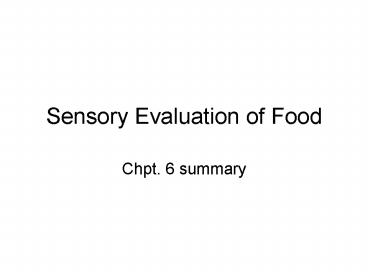Sensory Evaluation of Food - PowerPoint PPT Presentation
1 / 17
Title:
Sensory Evaluation of Food
Description:
Sensory Evaluation of Food Chpt. 6 summary Objectives/Terms Describe sensory characteristics that affect food preferences Terms: Flavor, Garnish, Monosodium Glutamate ... – PowerPoint PPT presentation
Number of Views:679
Avg rating:3.0/5.0
Title: Sensory Evaluation of Food
1
Sensory Evaluation of Food
- Chpt. 6 summary
2
Objectives/Terms
- Describe sensory characteristics that affect food
preferences - Terms Flavor, Garnish, Monosodium Glutamate,
Mouthfeel, olfactory, Sensory characteristics,
Sensory Evaluation, Sensory Evaluation Panel,
Taste Blind, Taste Buds, Volatile
3
Food Choices
- What influences food choices????
4
Culture and Heritage
- Preferences and Tastes are passed down
- Influenced by climate, geography and contact with
other cultures
5
Emotions
- Preferences often based on emotional associations
- good/bad memories
- Comfort foods
- Food choices make personal statements
- Advertisers take advantage of this
- Using specific, words, images and music to
advertise their products
6
Religious Beliefs
- Personal beliefs
- Dont believe in the slaughtering of animals
- Many religions have dietary laws
- No meat on Fridays
- Only Kosher foods
- No beef
- Fasting
7
Health Concerns
- Nutritional Value
- Certain physical conditions
- Lactose intolerant
- Diabetic
- Allergies
- Age
- Changes in health can alter eating patterns
8
Food Costs/Technology
- Budget may influence what you buy, cook and eat
- People who have to rely on government programs
are limited in their food choices - Adding new foods
- Increased access to foods
9
The Scientific Approach
- Sensory Evaluation
- Scientifically testing food, using human senses
of sight, smell, taste, touch and hearing - Sensory Characteristics
- The qualities of food identified by the eating
- How a food, looks, smells and feels when eating it
10
The Flavor Factor
- Flavor distinctive quality that comes from a
foods unique blend of appearance, taste, feel,
odor and sound - Involves all senses
- Appearance
- Can be a sign of quality, ripeness
- Sometimes appealing appearance is based on custom
- Green ketchup
- Green eggs and ham
11
Flavor Factor Cont
- Combinations of colors are important too!
- Catches your eye
- Garnish decorative arrangement added to food or
drink
12
Taste and Odor
- Think Fish??? Cookies??
- Taste Blind unable to distinguish between
flavors in some foods - May be caused by diseases, medication and medical
treatments - Colds, allergies, smoking
13
Taste and Odor Cont
- Taste Buds sensory organs located on your tongue
- Monosodium glutamate (MSG) salt that interacts
with other ingredients to enhance salty and sour
taste - Olfactory related to the sense of smell
- Responds to smells
14
Temperature
- Volatile substances that are easily changed into
vapor - Food may taste differently depending on
temperature - Some types of food are more sensitive to heat
than others - Heat increases the sweet taste of some sugars
15
Texture
- Mouth feel how food feels in the mouth
- SOUND
- Crunch
- Example soggy cereal is less appealing than
crispy cereal - Do you ever hear food cooking and get hungry???
16
Sensory Evaluation
- Sensory Evaluation Panels groups of people who
evaluate food samples - 3 main groups
- Highly Trained Experts judge the quality based
on standards set by the food industry. Work
individually - Laboratory Panels Small groups that work at a
company's lab. Help develop new products and
determone how to change existing products - Consumer Panels Used to test foods outside the
laboratory (grocery stores, malls, market
research forms) Using scientific terms to tell
how much they like or dislike the product
17
Uniform Evaluations
- Used to get the most reliable information
- Must make testing Experiences as uniform as
possible - 1. Minimize Distractions
- 2. Minimize Bias
- 3. Help evaluators use their senses to the fullest































